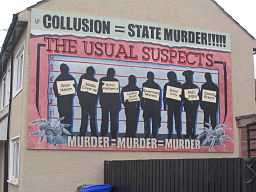Police lineup


A police lineup (in American English) or identity parade (in British English) is a process by which a crime victim or witness's putative identification of a suspect is confirmed to a level that can count as evidence at trial.
The suspect, along with several "fillers" or "foils"—people of similar height, build, and complexion who may be prisoners, actors or volunteers—stand side-by-side, both facing and in profile. The lineup sometimes takes place in a room for the purpose, one which may feature a one-way mirror to allow a witness to remain anonymous, and may include markings on the wall to aid identifying the person's height.
For evidence from a lineup to be admissible in court, the lineup itself must be conducted fairly. The police may not say or do anything that persuades the witness to identify the suspect that they prefer. This includes loading the lineup with people who look very dissimilar to the suspect.[1]
Alternatives
Alternatively, photographs of the suspect and fillers can be shown to the identifier in what is called a "photo-lineup", or a "six pack".[2] If the victim or witness successfully identifies the suspect from among the fillers, the identification is considered valid. There is some research into using other methods of photo-lineup that involve the witness sequentially viewing photographs rather than simultaneously.[3]
The sequential method is considered more accurate because it prevents the witness from looking at all the suspects and merely selecting the person that most resembles the guilty person.
A "show-up" is another alternative, in which a suspect is individually shown to a witness.[4]
Many UK police forces use VIPER, a digital system where witnesses view video recordings of suspects and unrelated volunteers.[5]
References
- ↑ "Where do police get the people for lineups?". The Straight Dope. 21 November 2006. Archived from the original on 2008-04-30. Retrieved 2007-07-07.
- ↑ Campbell, Andrea; Ohm, Ralph C. (2007). Legal Ease: A Guide to Criminal Law, Evidence, and Procedure (2nd ed.). Springfield, Ill.: Charles C. Thomas Publisher. p. 176. ISBN 0-398-07731-2.
- ↑ Zernike, Kate (2006-04-19). "Study Fuels a Growing Debate Over Police Lineups". The New York Times. Retrieved 2007-07-07.
- ↑ "Identification Procedures & Preparing the Case for Court". Administration of Justice 104. Rio Hondo College. August 2001 (last revision). Retrieved 2011-07-23.
- ↑ "Police to use virtual ID parades". BBC News. 1 April 2004. Retrieved 18 April 2012.
| |||||||||||||||||